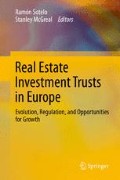Abstract
Between 1997 and 2007, Italy experienced a period of sustained growth in the real estate market and capital value growth has been strong in all sectors, as has income return on the commercial real estate sector. The real estate market was expansive and has been transformed by the introduction of new financial instruments as well as through foreign investors.
Access this chapter
Tax calculation will be finalised at checkout
Purchases are for personal use only
Notes
- 1.
Real Estate Investment Funds.
- 2.
TUF stands for Testo Unico della Finanza. See also Ministerial Decree n. 228, 24th May 1999, Bank of Italy Regulation, 20th September 1999.
- 3.
Properties in conflict of interests are all properties of equity holders and with other companies that belong to the group.
- 4.
D.M. 47 of 31st of January 2003 from the Ministry of Economy and Finance, the Law 326 of 24th November 2003, the Law 350 of 24th December 2003, the Law 63/2005, the Law 262/2005 and the Law 266/2005.
- 5.
Consob: Commissione Nazionale per le Società e la Borsa – Companies and Stock Exchange National Commission, which is the Italian regulatory authority for financial markets.
- 6.
SGR must be an Italian joint – stock company (Società per Azioni, SPA) which can carry out the activity of management of investment funds complying specific regulatory requirement and upon authorization and supervision of Bank of Italy.
- 7.
The bank must be an Italian bank or an Italian branch of an EU bank, with professional experience, minimum assets and structure which guarantees an efficient management of the investments.
- 8.
In Italian “Regolamento”.
- 9.
Regolamento sulla Gestione Collettiva del Risparmio, Bank of Italy, 14/04/2005.
- 10.
Law n. 122, 30/07/2010 and Law n. 106, 12/07/2011.
- 11.
See D.M. N. 228 of 24th of May 1999 for valuers’ requirements.
- 12.
See Bank of Italy’s Measure, 14th of April 2005; Bank of Italy and Consob Communication, 29th July 2010; Bank of Italy and Consob Communication 29th of October 2007; Assogestioni’s Guidelines, 27th of May 2010.
- 13.
According to Assogestioni, Funds’ investments, in 2012, where divided in real estate and real estate rights (90.1 %), shares in real estate companies (2 %), transferable securities and liquidity (5.7 %), others investments (2.3 %).
- 14.
Bank of Italy, Measures 14th of April, 2005.
- 15.
Qualified investors are defined in art. 31 of Consob Regulation 11522/1998. Reserved funds were introduced by D.lgs. 58 of 24th February 1998 (TUF), and are designed only for qualified investors. These are investors and institutions with experience in finance. They could be: banks, management-investment companies (Sgr), pension funds, insurance companies, finance companies, open-end companies and funds, mutual funds and private investors whose skill in financing and trading is recognised.
- 16.
Bank of Italy, Measure 14th April 2005.
- 17.
Until the year 2003 they were subject to a net wealth tax equal to 1 % on the average net accounting value of the fund. This tax was introduced in 2008 and it was repealed in 2010.
- 18.
Special Purpose Vehicles.
- 19.
This is commonly referred as the “White List”.
- 20.
Scenari Immobiliari, I fondi Immobiliari in Italia e all’estero, 2012.
- 21.
A semi-closed end fund allows an increase in the value of their initial capital by issuing new units.
- 22.
Index goes from 1 (Highly Transparent market) to 5 (Opaque market).
- 23.
IPD – Investment Property Database, a UK based performance measurement company that has established indexing services in the UK (since 1988) and other countries around the world.
- 24.
The IPD Italy Annual Property Index measures ungeared total returns to directly held standing property investment from one open market valuation to the next.
- 25.
The IPD Italy Biannual Property Index measures ungeared total returns to directly held standing property investment from one open market valuation to the next.
- 26.
The IPD Italy Biannual Property Fund Index measures geared and ungeared fund total returns from one open market valuation to the next and analyses 42 funds with a Net Asset Value of 7.7 Million Euros.
- 27.
The TradisSystem has also IFI – TR, Total Return Property Fund Index. It compares the different management of property funds, which reinvest the dividends.
- 28.
It could be an Italian permanent establishment of an EU real estate company whose shares are listed on a regulated market.
- 29.
SIIQ Regime.
- 30.
The concept of ‘real estate properties’ includes interests in SIIQs or Non-Listed SIIQs that qualify as long-term assets according to article 11(2) of Decree 28 February 2005, no 38. Dividends on the mentioned interests in SIIQs, which are paid out of profits relating to the real estate lease activity, qualify as revenues derived from the real estate rental activity.
References
Assogestioni. (2012). Fondi immobiliari. Rapporto semestrale, June 2013.
Bianchi, M. L., & Chiarera, A. (2012, April). Italian real estate investment funds: Market structure and risk management. Questioni di Economia e Finanza, Occasional Paper, n. 120, Banca d’Italia, pp. 1–32.
Colombo, A., & Marcelli, T. (2009, December). Il rapporto tra le SGR e gli esperti indipendenti nella fase di valutazione degli asset dei fondi immobiliari. Quaderni di Finanza, 65, Consob., pp. 1–51.
IPD. (2012). Italian property index.
Jones Lang Lasalle. (2012). RE tranparency index.
Nomisma. (2012). II Rapporto sul Mercato Immobiliare. Bologna.
Scenari Immobiliari. (2012). I fondi immobiliari in Italia e all’Estero. Rome.
Author information
Authors and Affiliations
Corresponding author
Editor information
Editors and Affiliations
Rights and permissions
Copyright information
© 2013 Springer-Verlag Berlin Heidelberg
About this chapter
Cite this chapter
Gabrielli, L. (2013). Fifteen Years of Italian Real Estate Investment Funds Across Different Market Cycles. In: Sotelo, R., McGreal, S. (eds) Real Estate Investment Trusts in Europe. Springer, Berlin, Heidelberg. https://doi.org/10.1007/978-3-642-36856-1_11
Download citation
DOI: https://doi.org/10.1007/978-3-642-36856-1_11
Published:
Publisher Name: Springer, Berlin, Heidelberg
Print ISBN: 978-3-642-36855-4
Online ISBN: 978-3-642-36856-1
eBook Packages: Business and EconomicsEconomics and Finance (R0)

